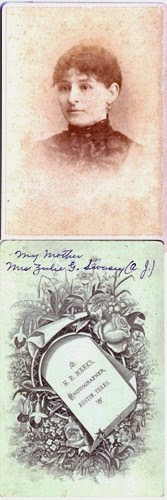(Second edition with some typos corrected at 10 am)
Don't think the worst of her when you see the title...women who make their living on their own are all professionals, and what that profession might be is often not the oldest profession women are known for. She made and sold hair tonic and dyes.
I just wrote my oldest sons that I'd found their grandmother's great grandmother. First you might be interested to know that I'm looking among my ex-husband's ancestors. And second, I remembered just a vague comment his mother made that her father had changed his name when he went on the stage, from Schultz to Hillyer. It was legal, because his mother had that name until she married.
So I was glad to see that Ancestry already had a nice tree started for their family. I mentioned a while back that they could trace their ancestors to those who stepped ashore from the Mayflower. My exhusband's brother had written a couple of sentences also about the name changing grandfather, so that corroborated my memory.
But this chase was much more recent than Mayflower times, going back about to the mid nineteenth century. People who were born around the time of the Civil War.
I only knew that the grandfather who changed his name was born in 1878 in KY, then tried Vaudeville for a while in NY, and finally married and settled into farming the rest of his life in Michigan. Lewis (Louis) Selwyn Schultz Hillyer born in Oct 1878 in KY.
So I tried looking for any records of his 2 surnames, Schultz, and Hillyer. The Selwyn might have been another addition, though some records do give him an initial S. But it could have stood for Schultz as well.
And bingo bango...I got lucky. I did find a few dead-end paths however along the way. One woman might have been his mother, except she had another child the year he had been born, as well as others on both other years before and after.
After a few hours I got lucky and found his actual birth record in Bellevue, Campbell County, KY. He's the 5th child listed below, born Dec 8.
And there were his mother and father's names, as well as where they had been born. Here his mother's name had a given name for the first time - Maggie. Her maiden name was mispelled Hillyser. And she was born in Cincinnati, OH, right across the river from Bellvue KY. Father was Louis Schultz Sr.
I won't go into the rest of the information I found about his early life, but it's now available for the family over on Ancestry. I found he did live in New York in a census of 1905, and gave his name as Hillyer, as well as his occupation as Professional, while living as a lodger as most single persons did in NY.
Since I now had Louis' mother's name, I did a search and started finding more about her. I did find she was probably born in Oct. 1852, lived most of her adult life in Bellevue, KY, and she died around age 51. And eventually I found her own mother Mrs. C. C. Hillyer. Catharine C. Hillyer was probably born in 1830 in New York state. There are at least 2 other Catharine C. Hillyers (Hiller) that aren't the same woman who lived in Cincinnati.
I believe that a woman who had one (or maybe 2) daughters to raise alone in the mid 1800s was quite clever to sell hair tonic. She is listed annually in the city directory from 1862-1875. I couldn't find out more about Mrs. Hillyer at this time...though I think some of the census records for Cincinnati were not quite accurate...or perhaps they were given misinformation for some reason or another. The census of 1860 is the earliest I could locate, and Cincinnati was immersed in the abolitionists movement.
I am glad to finally have the correct names and birth places for these ancestors of my children.

.jpg)

























.jpg)




